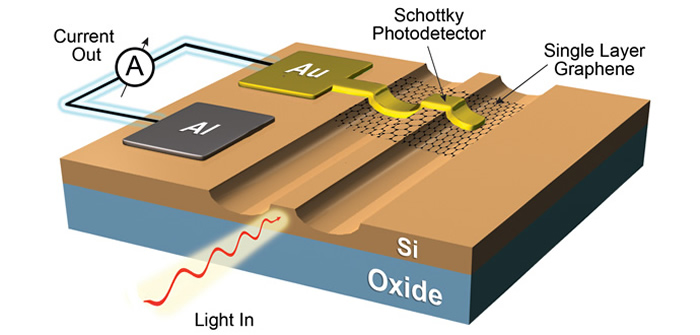Optical communication now graphene-based
Researchers from the Graphene Flagshi, as an important step towards graphene integration in silicon photonics, have published a paper which shows how graphene can provide a simple solution for silicon photodetection in the telecommunication wavelengths. Published in Nano Letters, this research is a collaboration between the University of Cambridge (UK), The Hebrew University (Israel) and John Hopkins University (USA).
The mission of the Graphene Flagship is to translate graphene out of the academic laboratories, through industry and into society. This broad and ambitious aim has been at the forefront of the choices made to direct the Flagship; it focuses on real problem areas where it can make a real difference such as in Optical Communications.
Optical Communications are increasingly important because they have the potential to solve one of the biggest problems of our information age: energy consumption. Almost everything we do in everyday life consumes information and all of this information is powered by energy.
If we want more and more information, we need more and more energy. In the near future, the major consumers of data traffic will be machine-to-machine communication and the IoT.

To enable the IoT and the level of information it requires, current silicon photonics has a problem: it needs ten times more energy than we can provide. So, if we want this new, improved internet age, new technological, power-efficient solutions need to be found. This is why the drive to graphene-based optical communication is so important.
Over the last few years, optical communications have increased their viability over standard metal-based electronic interconnects. The current silicon-based photodetector used in optical communications has a major issue when it comes to detecting data in the near infrared range, which is the range used for telecommunications.
The telecom industry has overcome this problem by integrating germanium absorbers with the standard silicon photonic devices. They have been able to make fully functioning devices on chips using this process. However, this process is complex.
In the new paper, graphene is interfaced with silicon on chip to make high responsivity Schottky barrier photodetectors. These graphene-based photodetectors achieve 0.37A/W responsivity at 1.55μm using avalanche multiplication. This high responsivity is comparable to that of the Silicon Germanium detectors currently used in silicon photonics.
Professor Andrea Ferrari from the Cambridge Graphene Center, who is also the Science and Technology Officer and the Chair of the Management Panel for the Graphene Flagship stated; “This is a significant result which proves that graphene can compete with the current state of the art by producing devices that can be made more simply, cheaply and work at different wavelengths. Thus paving the way for graphene integrated silicon photonics.”
Dr Ilya Goykhman, from the University of Cambridge, and the paper’s lead author, said; “The vision here is for graphene to play an important part in enabling optical communication technologies. This is a first step towards this, and, over the next two years the aim of the wafer-scale integration and optoelectronics work-packages of the Flagship is to really make this happen”.
Talking further about the Graphene Flagship and its collaborative approach to research, Professor Ferrari commented “Graphene can beat current silicon photonic technology in terms of energy consumption.
The Graphene Flagship is investing a lot of resources into wafer-scale integration with the creation of a new Work Package. We have identified a vision, where graphene is the backbone for data communication, and we plan to have a telecommunication bank capable of transferring 4×28 GB/s by 2018.
The research in this Nano Letters paper is the first step towards achieving that vision, the importance of which is clearly recognized by companies such as Ericsson and Alcatel-Lucent who have joined the Flagship to help develop it.”
“We have shown the potential for the detector but we also need to produce a graphene-based modulator to have a full, low energy optical telecommunication system and the Flagship is working hard on this problem.
The Flagship has collected the right people in the right place at the right time to work together towards this goal. Europe will be at the cutting edge of this technology. It is a great challenge, and a great opportunity for Europe, as there is such high added value to the devices it will be cost effective to manufacture the device in Europe – keeping the value of the technology within the European community,” said Professor Ferrari.
More information: Graphene Flagship

Comments are closed, but trackbacks and pingbacks are open.